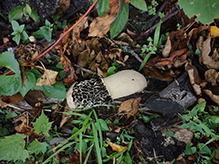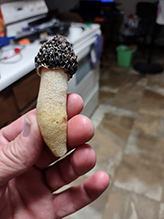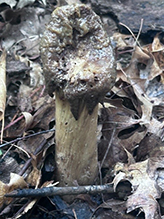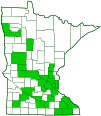Dune Stinkhorn
(Phallus hadriani)
Conservation • Description • Habitat • Ecology • Distribution • Taxonomy
|
|
||||||||||||||
Description |
Dune Stinkhorn is a common and widespread mushroom. It occurs in Europe and North America. It occurs throughout the United States, but it is mostly absent from the deep south and the Great Basin. It appears from June to October. It grows on the ground alone, in groups or in clusters, in sandy soil, cultivated soil, rich humus, compost, and woodchip piles. It is found in lawns, gardens, and parks. It is uncommon in natural areas. In the UK, it is found mostly on sand dunes. The fruiting body at first resembles a puffball partially or completely buried in the ground. It is egg-shaped, whitish, 1⅝″ to 2⅜″ (4 to 6 cm) high, and 1¼″ to 1⅝″ (3 to 4 cm) wide. It soon turns pinkish to lilac or purple. It is attached to the ground or other substrate by thread-like, branching, similarly colored strands (mycelium). The outside of the “egg” is the universal veil, protecting the developing mushroom. Inside the egg there is a gelatinous layer, an olive-green to olive-brown spore mass (gleba), and all of the fully formed parts of the mature stinkhorn. When conditions are right the egg ruptures and expands rapidly. In one or two days it produces a distinctly phallic structure with a stalk and thimble-like head. The rapid expansion is possible because all of the parts are fully formed and compressed inside the egg, and because the individual cells elongate, rather than new cells being produced. As the stinkhorn expands, the gelatinous layer mixes with the spore mass producing a shiny, putrid slime that covers the cap. The foul-smelling slime is irresistible to flies, which feed on it, lay their eggs in it, and transfer spores when they fly to other stinkhorns. It is a smelly nuisance to homeowners who find it under their wooden deck. On the mature fruiting body, the stalk is white to yellowish-white, spike-like, hollow, spongy, fragile, 4″ to 8″ (10 to 20 cm) long, and ⅝″ to 1¼″ (1.5 to 3.0 cm) wide. The remnants of the ruptured universal veil (volva) persist at the base of the stalk. The volva is cup-like, loose, lobed, and violet. It is often buried underground or hidden under leaves. There are usually one or more thick, similarly colored, mycelial cords at the base. The cap is thimble-like, up to 1½″ (4.0 cm) long, and ⅝″ to 1½″ (1.5 to 4.0 cm) wide. There is a white, circular opening at the top where it attaches to the stalk. There are sometimes remnants of a membranous veil attached to the bottom of the cap. At first, the cap When it is carried off by flies and/or washed off by rain it reveals a whitish, strongly pitted and ridged, honeycomb-like (reticulate) surface. All stinkhorns are edible but the slimy consistency inside the “egg” and the putrid odor of the mature specimen are enough to dissuade most from collecting it for the table. |
Similar Species |
Common Stinkhorn (Phallus impudicus) is typically taller, up to 11¾″ tall. The volva is white. Ravenel’s Stinkhorn (Phallus ravenelii) cap is granular, smooth or slightly wrinkled, but not deeply pitted and ridged surface. |
Habitat and Hosts |
Lawns, gardens, and parks; uncommon in natural areas. Sandy or cultivated soil, humus, compost, and woodchip piles. |
Ecology |
Season |
June to October |
Distribution |
||
|
Sources Biodiversity occurrence data published by: Minnesota Biodiversity Atlas (accessed through the Minnesota Biodiversity Atlas Portal, bellatlas.umn.edu, 6/25/2025). |
|
| 6/25/2025 | ||
Occurrence |
||
Common and widespread |
||
Taxonomy |
|
Kingdom |
Fungi (Fungi) |
Subkingdom |
Dikarya |
Phylum |
Basidiomycota (Basidiomycete Fungi) |
Subphylum |
Agaricomycotina (Higher Basidiomycetes) |
Class |
Agaricomycetes (Mushrooms, Bracket Fungi, Puffballs, and Allies) |
Subclass |
Phallomycetidae |
Order |
Phallales (stinkhorns and allies) |
Family |
Phallaceae (stinkhorns) |
Genus |
Phallus |
|
|
Subordinate Taxa |
|
|
|
Synonyms |
|
Hymenophallus hadriani Ithyphallus impudicus var. imperialis Ithyphallus impudicus var. iosmus Phallus imperialis Phallus iosmus |
|
Common Names |
|
Dune Stinkhorn Hadrian’s Stinkhorn Purple-egg Stinkhorn Sand Stinkhorn |
|
Glossary
Gleba
The inner spore-bearing mass of puffballs, earthstars, and stinkhorns. The term is also used to refer to the spore-bearing slime covering the head of a stinkhorn.
Mycelium
The vegetative part of a fungus; consisting of a mass of branching, thread-like hyphae, through which a fungus absorbs nutrients from its environment; and excluding the fruiting, reproductive structure.
Saprobic
A term often used for saprotrophic fungi. Referring to fungi that obtain their nutrients from decayed organic matter.
Universal veil
An egg-like structure that envelopes all or most of a developing gill mushroom. Remnants of the universal veil sometimes visible on a mature mushroom are patchy warts on the cap, a ring on the stem, and a volva at the base of the stem.
Volva
Also called cup. A cup-like covering at the base of a mushroom stem, sometimes buried. In Amanita, Volvariella, and some other mushrooms, it is the remnants of the universal veil ruptured by the mushroom pushing through. In Phallales it is the remnants of the ruptured peridium.
Visitor Photos |
||
Share your photo of this fungus. |
||
This button not working for you? |
||
Kari M. |
||
Found in the same location one week apart. This is the second stinkhorn found at this same location. |
||
 |
 |
|
Paul |
 |
MinnesotaSeasons.com Photos |
||
|
||
|
||

Slideshows |
|

Visitor Videos |
||
Share your video of this fungus. |
||
This button not working for you? |
||
|
Other Videos |
||
|

Visitor Sightings |
||
Report a sighting of this fungus. |
||
This button not working for you? |
||
Kari M. |
Location : Waseca, MN, Waseca County |
 |
Kari M. |
Location : Waseca, MN, Waseca County |
MinnesotaSeasons.com Sightings |
||
|

|
Created: 8/15/2024 Last Updated: © MinnesotaSeasons.com. All rights reserved. |
